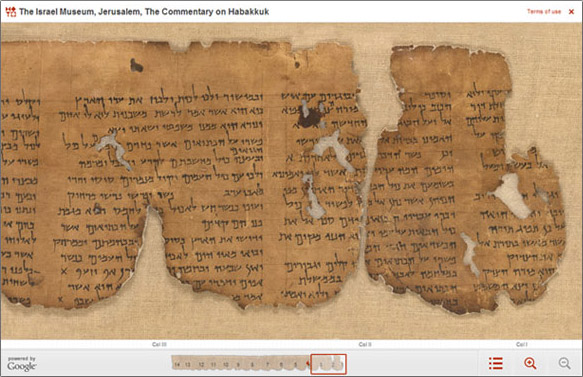The Commentary on Habakkuk Scroll
Click to examine the scroll.
The Commentary on Habakkuk Scroll (1QpHab) •
Qumran, Cave 1 •
1st century CE •
Parchment •
H: 14; L: 148 cm •
Government of Israel •
Accession number: 95.57/28
In this work, the verses of the biblical book are copied paragraph by paragraph, in their original order. The scriptural text of Habakkuk on which the commentary is based, however, appears to be at variance from time to time with the Masoretic text. Each paragraph is accompanied by a commentary, introduced by the Hebrew word pishro, "its meaning," or pesher hadavar al, "the meaning of the matter is in regard to." The commentary uses a prophetic style to address events of the author's time.
Two major subjects are treated in this composition. One relates to the internal religious politics of Jerusalem and the Temple priesthood, and the other – to the repercussions of the appearance of the Romans (called in the work Chaldeans or Kittim) on the historical scene. As in most of works of this genre, no historical personages are mentioned by name, but there are allusions to such individuals as "the Teacher of Righteousness," "the Wicked Priest," "the Man of Lies," and others, whose exact identities have yet to be established.
This exceptionally well-preserved scroll is a key source of our knowledge of the spiritual life of the secluded Qumran community. It sheds light on the community's perception of itself and serves as paradigm against which other examples of this genre (such as Pesher Nahum or Pesher Micah) are evaluated.
Comentário sobre a Habacuque (Habacuque Pesher, 1QpHab), é um pergaminho em relação completa (1,48 m de comprimento) e uma das sete originais manuscritos do Mar Morto descobertos em cavernas de Qumran, em 1947. Ele interpreta os dois primeiros capítulos do livro bíblico do profeta Habacuque, dispõe de 13 colunas escritas em hebraico, de forma clara, script quadrados de Herodes. No entanto, o tetragrama, a carta de quatro, o nome inefável de Deus, está escrito em caracteres hebraicos antigos, ao contrário do resto do texto. O pergaminho foi datado da segunda metade do primeiro século aC.
Neste trabalho, os versos do livro bíblico são copiados parágrafo por parágrafo, em sua ordem original. O texto bíblico de Habacuque em que o comentário é baseado, entretanto, parece estar em desacordo de tempos em tempos com o texto massorético. Cada parágrafo é acompanhada por um comentário, iniciada com a palavra hebraica pishro ", seu significado", ou hadavar pesher al ", o significado da questão é em relação a". O comentário usa um estilo profético para tratar eventos do tempo do autor.
Dois grandes temas são tratados nesta composição. Uma diz respeito à política interna religiosas de Jerusalém e do sacerdócio do Templo, e os outros - para as repercussões do aparecimento dos romanos (chamado no trabalho ou caldeus Quitim) na cena histórica. Como na maioria das obras deste gênero, não personagens históricos são mencionados pelo nome, mas há alusões aos indivíduos, tais como "Mestre da Retidão", "o Sacerdote Perverso", "o Man of Lies", e outros, cuja exata identidades ainda não foram estabelecidas.
Este pergaminho excepcionalmente bem preservado é uma fonte-chave de nosso conhecimento da vida espiritual da comunidade Qumran isolado. Ela lança luz sobre a percepção da comunidade sobre si mesma e serve como paradigma contra o qual outros exemplos deste género (como Pesher Nahum ou Micah Pesher) são avaliados.
Fonte: http://dss.collections.imj.org.il/habakkuk


Nenhum comentário:
Postar um comentário